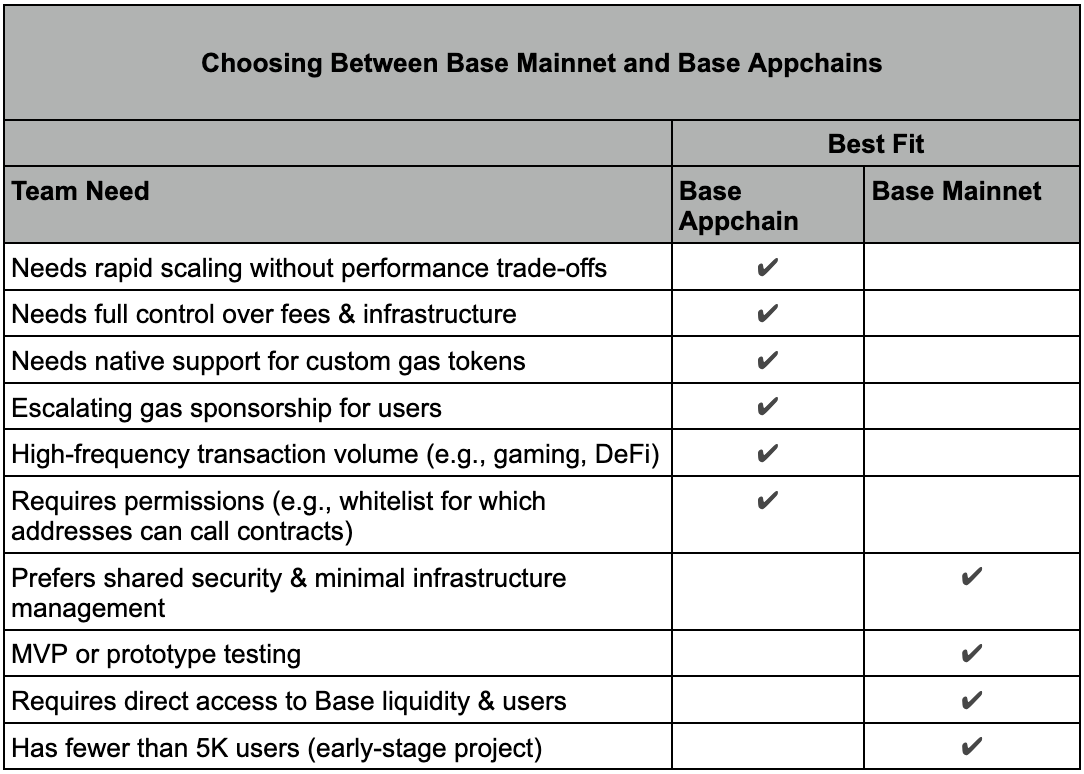General
How does Appchains work?
Appchains are for projects seeking scale at low cost through dedicated blockspace, with customizable gas tokens and permissions.How do I create an Appchain?
We are selecting early access customers off our waitlist. Once approved, you’ll get access to both testnet and mainnet features for Base Appchains.How do I know if Appchains are right for me?
Appchains are for mature projects who want full control over their infrastructure, are seeking scale through dedicated blockspace, and/or are considering custom gas tokens.
I am considering launching my own altL1 or L2 Rollup — should I be deploying a Base Appchain instead?
Appchains are a great alternative to launching an altL1 or L2. As an extension of the Base ecosystem, Appchains benefit from Ethereum alignment, co-marketing, liquidity and users of Base Mainnet. Additionally, Appchains provide:- Dedicated blockspace, insulating your chain from congestion that may arise from onchain activity unrelated to your app
- 1 second blocktimes, high throughput, sub cent transactions and cheap/predictable infra costs
- <10 second withdrawals back to Base Mainnet, enabling seamless cross-chain interactions
- Enterprise grade managed sequencer and nodes
- Customizable gas tokens (e.g. your app or protocol’s token)
- Custom permissions (e.g. contract allowlisting to specify which contracts can be interacted with on your chain)
- Predeployed, fundamental contracts
- Hosted block explorer
- Out of the box bridge UI with OnchainKit
- Access to Base Wallet support and builder tools like Paymaster and Bundler (enabling gas abstractions)
- No vendor lock-in (we’ll help you migrate off of CDP if you become unhappy with our service)
What is the difference between Base and an Appchain?
Base is a secure blockchain built for everyone. Build your application on Base when you are just starting out, have a few users, and are still prototyping your product. Once you’ve grown to a significant amount of daily or monthly active users you may be ready for an appchain. Appchains allow customers to have their own dedicated chain that settles to Base (aka Base L3s). A strong indicator for moving to an Appchain would be the costs of your Paymaster sponsored transactions for your applications.Who is building on Base Appchains today?
Today, Appchains are home to onchain businesses across DePin, gaming, creative, ERP and privacy. We imagine Appchains will grow to serve all onchain use cases. Read more about our customers here.I have a token on Base Mainnet — can I launch an Appchain with my token as the gas token?
Yes, you can launch an Appchain with your token as the gas token.What are Custom Gas Tokens (“CGTs”)?
CGTs allow for a Base ERC20 token to act as the gas token on an Appchain. The CGT must satisfy the standard ERC20 interface and implementation along with a few other properties. Once these properties are satisfied, the CGT can be used as the gas token on an Appchain and can be used to pay for transactions on the Appchain. See the Optimism docs for more information on custom gas tokens.What types of permissions can I set for my Appchain?
An allowlist is a configurable feature on Base Appchains that restricts which contracts can be called on the chain. While any address can deploy contracts, the allowlist determines which contracts are eligible for interactions.Onboarding
How do I get started with Base Appchains?
We are actively reviewing and selecting early access customers off our waitlist. Once approved, you’ll get access to both testnet and mainnet features for Base Appchains. If you have any questions, please reach out to us via Discord in the Appchains channel.What is required to create a testnet?
With a Coinbase Developer Platform account and a valid payment method you can create a testnet Appchain in a few clicks. Add a payment method by:- Navigating to the CDP Portal
- Clicking the Billing tab
- Clicking the Add payment method button
- Navigate to the CDP Portal
- From the left hand menu select Onchain Tools > Base Appchains
- Click the Deploy Testnet button

